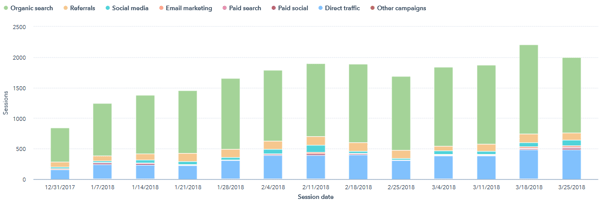As a marketer, there is one thing I rely on to guide my decisions regarding future strategy and past efforts—data. Fortunately, in today’s digital world, technology allows for easy marketing reporting and data analysis. Here is an overview of some of the key metrics and closed loop reporting we can use to analyze on and drive decisions.
Website Traffic Performance
.jpg?width=320&name=modern-technologies-1263422_1920%20(1).jpg) At Leighton Engage, the marketing platform we utilize is HubSpot. In reviewing website traffic, analyze the following:
At Leighton Engage, the marketing platform we utilize is HubSpot. In reviewing website traffic, analyze the following:
- Sources of traffic
- Organic traffic
- Referral traffic
- Social media traffic
- Direct traffic
- Email marketing
- Other sources of traffic that are tracked
- What pages are high impact (high time on page and low bounce rate or exit percentage)
- What are the next and previous pages to the high impact ones
- Any other relevant metrics based on the client and/or task at hand
Look at this data over time and also in comparison with other time frames - either the previous period or the previous year during the same time frame. Analyze all time frames you can—month over month, six-month span, year over year, or all time. This way, you can identify trends over time.
Lead Analytics
For lead analysis, look at CTA performance, their corresponding landing page metrics, and conversion rates. Consider things like:
- How many people are clicking on CTA’s?
- How many are converting?
- Where are the leads coming from?
- Are leads increasing or decreasing?
- If leads are not increasing, how can I impact this?
- Is each of the offers still relevant?
- Is it easy for the user to find the offer and does its placement make sense?
- Could the landing page copy be improved if conversions are low?

Here again, look at this data month over as many time frames as possible and all time to identify opportunities and trends. Let the data drive future offers, CTA, and landing page decisions.
Blog performance Data
In reviewing blog analytics, look at the following:
- Top performing posts for each month against what was published for that month
- Top performing posts that were published anytime to see what is performing well, since content lives forever
- Use those top-performing posts as opportunities to re-optimize and publish again with new information, updated statistics and relevant links to topics posted since it first went live
- Trends of topics people are responding to via comments, social shares, or visits
- How people found the blog content (sources)
In reviewing this data, craft future content around what people want and are responding to. Let data drive these decisions.
Social Analytics Measurement
In reviewing social media data, I analyze a lot of different components. Things such as:
- How much traffic was driven by social media
- Followers on each social channel – increases and decreases
- Interactions
- Clicks
- Shares
- Any contest data
- Ads – performance vs. spend
- Video performance – views, play time, results
Let data drive the future direction for social media strategy.
Website Page Performance
Some of the keys to understanding website page trends are reviewing the following:
- Visits by page
- How people are interacting with the page
- Add-on tools like HotJar, which provides data such as move maps, click maps, and scroll maps so you can understand site behavior trends
- How people are moving throughout the site
Review HubSpot data, as well as Google Analytics to help with website optimization. Here again, make data-driven decisions for website strategy.
Other Marketing Efforts
In addition to reviewing the above data, it's always a good idea to compare findings and analyze it all from a big picture perspective by taking into consideration other factors or variables that may be impacting results. These include things like:
- Seasonality of the business
- Trade shows/events/conferences
- Radio advertising
- Billboard advertising
- Mailers
- Direct advertising
- Online strategies
- Any other factors affecting the business
As you can see, there is a lot associated with analyzing results for marketing reporting. But, the good thing? If you listen and observe, the data will tell you where you need to go next. Using digital marketing analytics data to drive your decisions is a fool-proof way to increase results. Whether those results are more visits, more leads, or more revenue; effective data analysis is the answer.




Leave a Comment